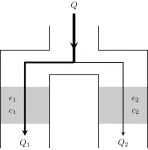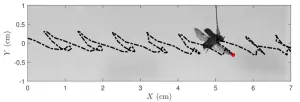(Press-News.org) Led by researchers from NYU Grossman School of Medicine and University of Szeged in Hungary, a new study in mice and rats found that restoring certain signals in a brain region that processes smells countered depression.
Publishing in the journal Neuron online May 9, the study results revolve around nerve cells (neurons), which “fire” – or emit electrical signals – to transmit information. Researchers in recent years discovered that effective communication between brain regions requires groups of neurons to synchronize their activity patterns in repetitive periods (oscillations) of joint silence followed by joint activity. One such rhythm, called “gamma,” repeats about 30 times or more in a second, and is an important timing pattern for the encoding of complex information, potentially including emotions.
Although its causes remain poorly understood, depression is reflected in gamma oscillation changes, according to past studies, as an electrophysiological marker of the disease in brain regions that manage the sense of smell, which have also been tied to emotions. These regions include the olfactory bulb adjacent to the nasal cavity, which is thought to be a source and “conductor” of brain-wide gamma oscillations.
To test this theory, the current study authors shut down the function of the bulb using genetic and cell signaling techniques, observed a related increase of depression-like behaviors in study rodents, and then reversed these behaviors using a device that boosted gamma signals of the brain at their natural pace.
“Our experiments revealed a mechanistic link between deficient gamma activity and behavioral decline in mice and rat models of depression, with the signal changes in the olfactory and connected limbic systems similar to those seen in depressed patients,” says corresponding study author Antal Berényi, MD, PhD, adjunct assistant professor in the Department of Neuroscience and Physiology at NYU Langone Health. “This work demonstrates the power of gamma-enhancement as a potential approach for countering depression and anxiety in cases where available medications are not effective.”
Major depressive disorder is a common, severe psychiatric illness often resistant to drug therapy, the researchers say. The prevalence of the condition has dramatically increased since the start of the pandemic, with more than 53 million new cases estimated.
Gamma Waves Linked to Emotions
Disease-causing changes in the timing and strength of gamma signals, potentially caused by infections, trauma, or drugs, from the olfactory bulb to other brain regions of the limbic system, such as the piriform cortex and hippocampus, may alter emotions. However, the research team is not sure why. In one theory, depression arises, not within the olfactory bulb, but in changes to its outgoing gamma patterns to other brain targets.
Removal of the bulb represents an older animal model for the study of major depression, but the process causes structural damage that may cloud researchers’ view of disease mechanisms. Thus, the current research team designed a reversible method to avert damage, starting with a single, engineered strand of DNA encapsulated in a harmless virus, which when injected into neurons in the olfactory bulbs of rodents caused the cells to build certain protein receptors on their surfaces.
This let the researchers inject the rodents with a drug, which spread system-wide, but only shut down the neurons in the bulb that had been engineered to have the designed drug-sensitive receptors. This way the investigators could selectively and reversibly switch off the communication between the bulb partner brain regions. These tests revealed that chronic suppression of olfactory bulb signals, including gamma, not only induced depressive behaviors during the intervention, but for days afterward.
To show the effect of the loss of gamma oscillation in the olfactory bulb, the team used several standard rodent tests of depression, including measures of the anxiety that is one of its main symptoms. The field recognizes that animal models of human psychiatric conditions will be limited, and so uses a battery of tests to measure depressed behaviors that have proven useful over time.
Specifically, the tests looked at how long animals would spend in an open space (a measure of anxiety), whether they stopped swimming earlier when submerged (measures despair), whether they stopped drinking sugar water (took less pleasure in things), and whether they refused to enter a maze (avoided stressful situations).
The researchers next used a custom-made device that recorded the natural gamma oscillations from the olfactory bulb, and sent those paced signals back into the rodents’ brains as closed-loop electrical stimulation. The device was able to suppress gamma in healthy animals or amplify it. Suppression of gamma oscillations in the olfactory lobe induced behaviors resembling depression in humans. In addition, feeding an amplified olfactory bulb signal back into the brains of depressed rats restored normal gamma function in the limbic system, and reduced the depressive behaviors by 40 percent (almost to normal).
“No one yet knows how the firing patterns of gamma waves are converted into emotions,” says senior study author György Buzsáki, MD, PhD, the Biggs Professor in the Department of Neuroscience and Physiology at NYU Langone Health and a faculty member in its Neuroscience Institute. “Moving forward, we will be working to better understand this link in the bulb, and in the regions it connects to, as behavior changes.”
Along with Berényi and Buzsáki, the study was led by Orrin Devinsky, MD, professor in the in Department of Neurology at NYU Langone, and director of its Comprehensive Epilepsy Center. Berényi is also principal investigator of the Momentum Oscillatory Neuronal Networks Research Group, Department of Physiology at the University of Szeged in Hungary, along with first study authors Qun Li and Yuichi Takeuchi, and authors Jiale Wang, Levente Gellért, Livia Barcsai, Lizeth Pedraza, Anett Nagy, Gábor Kozák, Gyöngyi Horváth, Gabriella Kékesi and Magor Lőrincz. Study authors Shinya Nakai and Masahiro Ohsawa are with the Department of Neuro-pharmacology, Graduate School of Pharmaceutical Sciences, at Nagoya City University in Japan. Takeuchi is also faculty in the Department of Physiology, Osaka City University Graduate School of Medicine and Faculty of Pharmaceutical Sciences, Hokkaido University in Japan. Also study authors were Shigeki Kato and Kazuto Kobayashi Department of Molecular Genetics, Institute of Biomedical Sciences at Fukushima Medical University School of Medicine in Japan.
Funding for the study was provided through grants from the Hungarian Academy of Sciences Momentum II program, the National Research, Development and Innovation Office of Hungary, the Ministry of Innovation and Technology of Hungary, the Ministry of Human Capacities, Hungary, the Hungarian Scientific Research Fund, the Hungarian Brain Research Program, the European Union Horizon 2020 Research and Innovation Program, the Japan Society for the Promotion of Science, the Japan Ministry of Education, Culture, Sports, Science and Technology, the Japan Agency for Medical Research and Development, as well as by support from The Kanae Foundation for the Promotion of Medical Science, the Life Science Foundation of Japan, the Takeda Science Foundation, the
Japanese Neural Network Society, and the János Bólyai Fellowship.
Media Inquiries:
Greg Williams
212-404-3500
gregory.williams@nyulangone.org
STUDY LINK (which will go live after the embargo lifts):
URL: https://www.cell.com/neuron/fulltext/S0896-6273(23)00298-2
DOI: 10.1016/j.neuron.2023.04.013
END
Potential found to counter depression by restoring key brain rhythm
Study proposes role for gamma oscillations in future treatment
2023-05-09
ELSE PRESS RELEASES FROM THIS DATE:
Evidence of Ice Age human migrations from China to the Americas and Japan
2023-05-09
Scientists have used mitochondrial DNA to trace a female lineage from northern coastal China to the Americas. By integrating contemporary and ancient mitochondrial DNA, the team found evidence of at least two migrations: one during the last ice age, and one during the subsequent melting period. Around the same time as the second migration, another branch of the same lineage migrated to Japan, which could explain Paleolithic archeological similarities between the Americas, China, and Japan. The study appears May 9 in the journal Cell Reports.
“The Asian ...
Trends in deaths from falls among adults age 65 or older
2023-05-09
About The Study: Between 1999 and 2020, deaths coded as being caused by falls among adults age 65 or older in the U.S. increased in number and rates for the overall population and for every population subgroup, although the magnitude of the increase varied. However, the relative ranking of the different groups has not changed over time.
Authors: Alexis R. Santos-Lozada, Ph.D., of Pennsylvania State University in University Park, is the corresponding author.
To access the embargoed study: Visit our For The Media website at this link https://media.jamanetwork.com/
(doi:10.1001/jama.2023.3054)
Editor’s ...
Extracting the best flavor from coffee
2023-05-09
WASHINGTON, May 9, 2023 – Espresso coffee is brewed by first grinding roasted coffee beans into grains. Hot water then forces its way through a bed of coffee grains at high pressure, and the soluble content of the coffee grains dissolves into the water (extraction) to produce espresso.
In 2020, researchers found that more finely ground coffee beans brew a weaker espresso. This counterintuitive experimental result makes sense if, for some reason, regions exist within the coffee bed where less or even no coffee is extracted. This uneven extraction becomes more pronounced when coffee is ground more finely.
In Physics of Fluids, from AIP Publishing, ...
Preserving pine forests by understanding beetle flight
2023-05-09
WASHINGTON, May 9, 2023 – The mountain pine beetle is one of the main causes of tree mortality in the pine forests of North America. For example, the insect has killed thousands of acres of pine forest in British Columbia and Alberta, and as a result, the areas are more vulnerable to wildfire. Increased tree mortality has turned Canada’s forests into a large net source of atmospheric carbon dioxide – emitted from the burned or decaying wood of dead trees – rather than a sink.
In Physics of Fluids, by AIP Publishing, researchers from the University of Alberta studied the flight performance of the mountain pine beetle from a fluid mechanics and an entomological perspective. ...
US gun violence: half of people from Chicago witness a shooting by age 40, study suggests
2023-05-09
Study following Chicagoans over a 25-year period suggests over half of the city’s Black and Hispanic population, and a quarter of its White population, have seen a shooting by age 40.
Researchers followed over two thousand people, with 50% of all the study’s participants witnessing a shooting.
Average age when first witnessing a shooting was just 14 years old.
Women only slightly less likely than men to witness shootings, despite men being far more likely to get shot.
Such levels of violence exposure may cause chronic stress and knock-on health implications for populations in Chicago and elsewhere.
A ...
Assessment of medical cannabis and health-related quality of life
2023-05-09
About The Study: In this study, patients using medical cannabis reported improvements in health-related quality of life, which were mostly sustained over time. Adverse events were rarely serious but common, highlighting the need for caution with prescribing medical cannabis.
Authors: Thomas R. Arkell, Ph.D., of the Swinburne University of Technology in Melbourne, Victoria, Australia, is the corresponding author.
To access the embargoed study: Visit our For The Media website at this link https://media.jamanetwork.com/
(doi: ...
Making vaccines longer lasting
2023-05-09
The SARS-Cov-2 pandemic illustrates how variable vaccines can be in their length of efficacy, with regular boosters needed to keep people protected. In comparison, the immunity generated by a single vaccination against the measles virus can last decades.
It has always remained a scientific mystery as to why only some vaccines lead to life-long protection. Now a paper published in the journal, Immunity, led by Prof. David Tarlinton and Dr Marcus Robinson, both from Monash University’s Central Clinical School in Melbourne, Australia, has found that the clue likely lies in the body producing a unique subtype of an immune cell in response to some ...
Long-term study pinpoints who has been shot and witnessed shootings by race, sex, and birth year
2023-05-09
Exposure to gun violence is one of the great traumas of American life, but its harms are not equally distributed. In a first-of-its-kind study published Tuesday in JAMA Network Open, a Harvard sociology professor and his colleagues set out to examine exposure to shootings by race, sex, and birth year in a long-term study that followed respondents from childhood up to age 40.
“The idea here is to take a life-course perspective,” said Robert J. Sampson, the Woodford L. and Ann A. Flowers University Professor. ...
Not all statins are created equal
2023-05-09
We’ve all recently gotten a crash-course in drug repurposing, thanks to near-daily news reports about efforts to identify existing medicines that could help treat COVID-19 in the early phase of the pandemic. A team of scientists at the Wyss Institute at Harvard University jumped into the fray in the spring of 2020, applying novel computational drug repurposing approaches to confront the COVID-19 challenge. This early work led to the surprising prediction that a some, but not all, types of statins (drugs that are widely prescribed to lower cholesterol) might protect patients against SARS-CoV-2 infection. In the flurry of clinical studies being published by other scientists studying ...
Motion capture and 3D scans bring history to life for new Dambusters docudrama
2023-05-09
A new docudrama featuring the attack on the Sorpe Dam, using motion capture technology and 3D scans to create life-like digital representations of RAF 617 Squadron aircrew, is being premiered in Bristol on 13 May 2023 to coincide with the 80th anniversary of the Dambusters raid.
Bristol-based film maker Andrew Panton worked with University of Bath researchers at CAMERA, using the latest digital technology to recreate specific scenes for a film featuring the attack on the Sorpe Dam.
Andrew started working on the documentary in 2017 with the last surviving Dambuster George ...
LAST 30 PRESS RELEASES:
Trauma or toxic? A deep dive into the impact of stress on kids' health
Turning industrial exhaust into useful materials with a new electrode
ORNL to partner with Type One Energy, UT on world-class facility to validate next-gen fusion
New journal section tackles AI, ethics, and digital health communication
Jeonbuk National University researchers develop novel dual-chemical looping method for efficient ammonia synthesis
New study sheds light on stroke recovery via exercise-induced migration of mitochondria
SEOULTECH researchers develop sodium-based next-generation smart electrochromic windows
Data-driven analysis reveals three archetypes of armed conflicts
Heart disease, stroke deaths down, yet still kill more in US than any other cause
Light switches made of ultra-thin semiconductor layers
Creative talent: has AI knocked humans out?
Sculpting complex, 3D nanostructures with a focused ion beam
A year after undermining Bredt’s rule, UCLA scientists have made cage-shaped, double-bonded molecules that defy expectations
Human activities drive global dryland greening
PeroCycle announces new appointments as it builds a world-class board for meaningful climate impact
Magnetic avalanches power solar flares
LeapSpace goes live: the Research-Grade AI-Assisted Workspace built on trusted science
DNA tests reveal mysterious beluga family trees
Strategic sex: Alaska’s beluga whales swap mates for long-term survival
How early cell membranes may have shaped the origins of life
Cannabis legalization is driving increases in marijuana use among U.S. adults with historically lower consumption rates
Multifunctional dipoles enabling enhanced ionic and electronic transport for high‑energy batteries
Triboelectric nanogenerators for future space missions
Advancing energy development with MBene: Chemical mechanism, AI, and applications in energy storage and harvesting
Heteroatom‑coordinated Fe–N4 catalysts for enhanced oxygen reduction in alkaline seawater zinc‑air batteries
Meta-device for precision lateral displacement sensing
Plasma-guided mitotane for the treatment of adrenocortical carcinoma: adjuvant care to advanced disease
Theoretical study of laser-enhanced nuclear fusion reactions
Social environment impacts sleep quality
Optimized kinetic pathways of active hydrogen generation at Cu2O/Cu heterojunction interfaces to enhance nitrate electroreduction to ammonia
[Press-News.org] Potential found to counter depression by restoring key brain rhythmStudy proposes role for gamma oscillations in future treatment



